Easy Vegetable Lasagna with Tomato
An Easy Vegetable Lasagna with Tomato made without meat. Ideal for family weeknight meals, it’s layered with veggies in a rich tomato sauce and creamy béchamel.
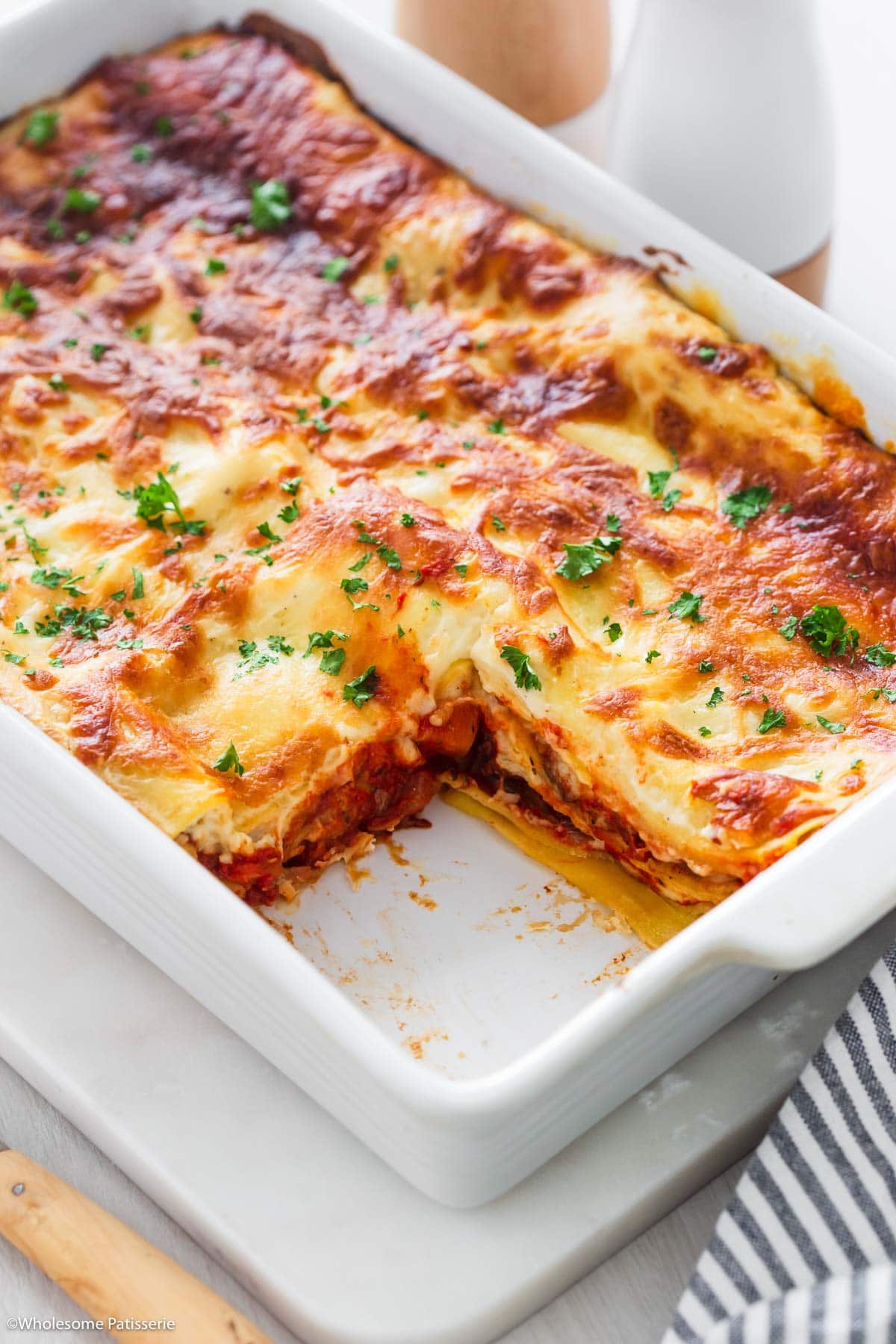
This Easy Vegetable Lasagna recipe is an easy yet highly flavorful approach to the classic Italian dish.
If you need a lasagna without tomatoes, my White Sauce Vegetable Lasagna is an excellent alternative.
It’s the ultimate crowd-pleaser main course. Equally adored by kids and adults.
This easy lasagna has a blend of tender lasagna noodles layered with a medley of fresh vegetables enveloped in a seasoned tomato sauce.
Complemented by a velvety layer of creamy béchamel sauce.
Which you’ll also find in my Potato Vegetable Bake.
For a quick pasta version, try my Creamy Red Sauce Spiral Pasta. Or without the tomato, my easy creamy broccoli pasta is a hit!
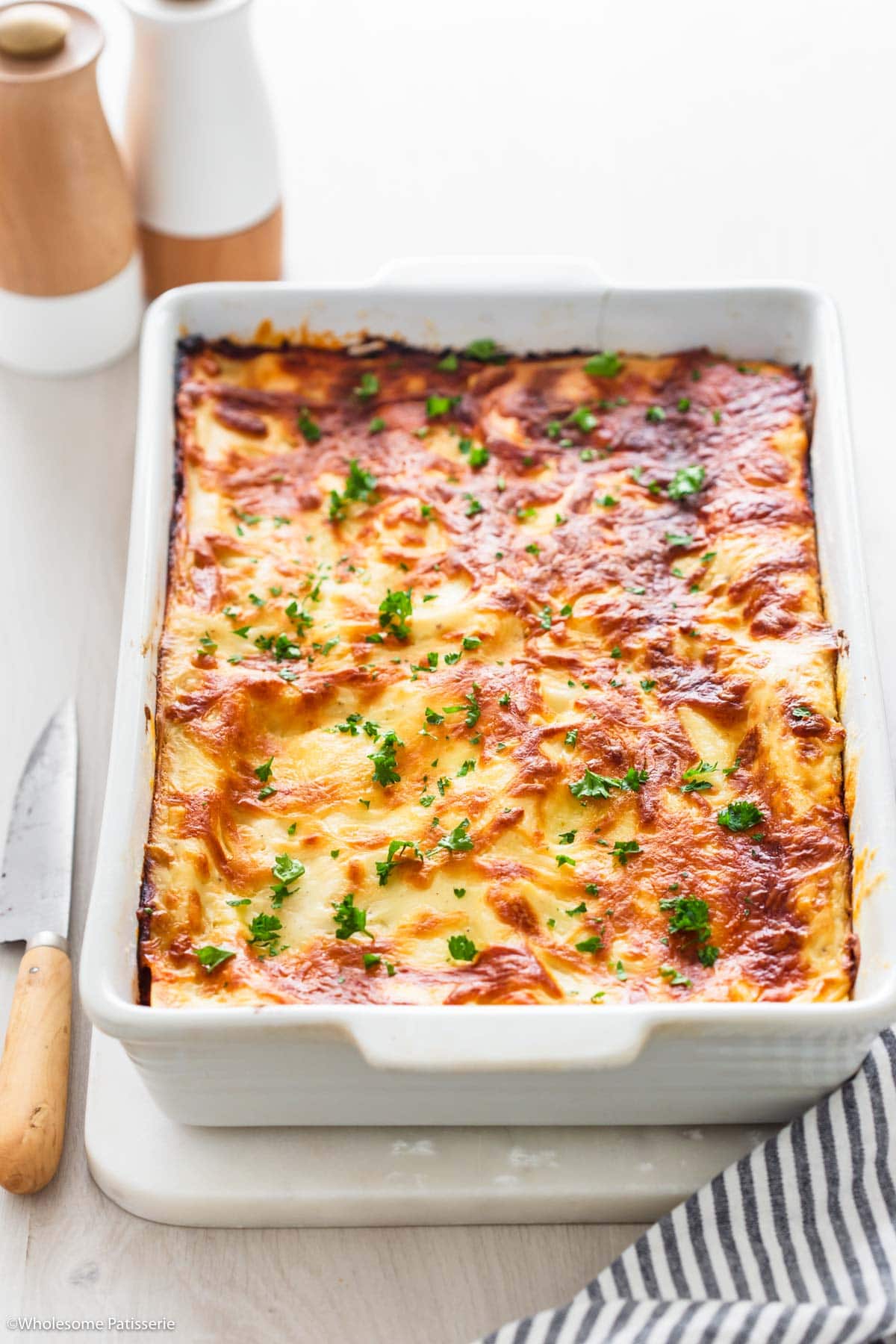
A variety of veggies like zucchini, carrot and eggplant add color and nutrients to the rich tomato layer.
It’s made without ricotta and spinach.
Instead, the easy white sauce layer is crafted with butter, flour, milk, cheese and a dash of seasonings.
Served alongside my Air Fryer Roasted Canned Potatoes, this lasagna makes a fantastic main dish recipe.
For oven roasted potatoes, try my Crispy Garlic Smashed Potatoes.
Why You Will Love This Recipe
- Made without meat.
- No ricotta or spinach.
- Feeds the whole family.
- Made with staple ingredients.
- Uses dried or fresh lasagna sheets.
- Can be made gluten-free.

What Type of Noodles Should I use for Lasagna?
It’s best to use fresh or oven-ready (aka no-boil) lasagna noodles.
I have used regular/dried lasagna sheets with success too. I didn’t even cook them beforehand as the consistency of the tomato sauce layer was enough for it to be soaked up by the noodles.
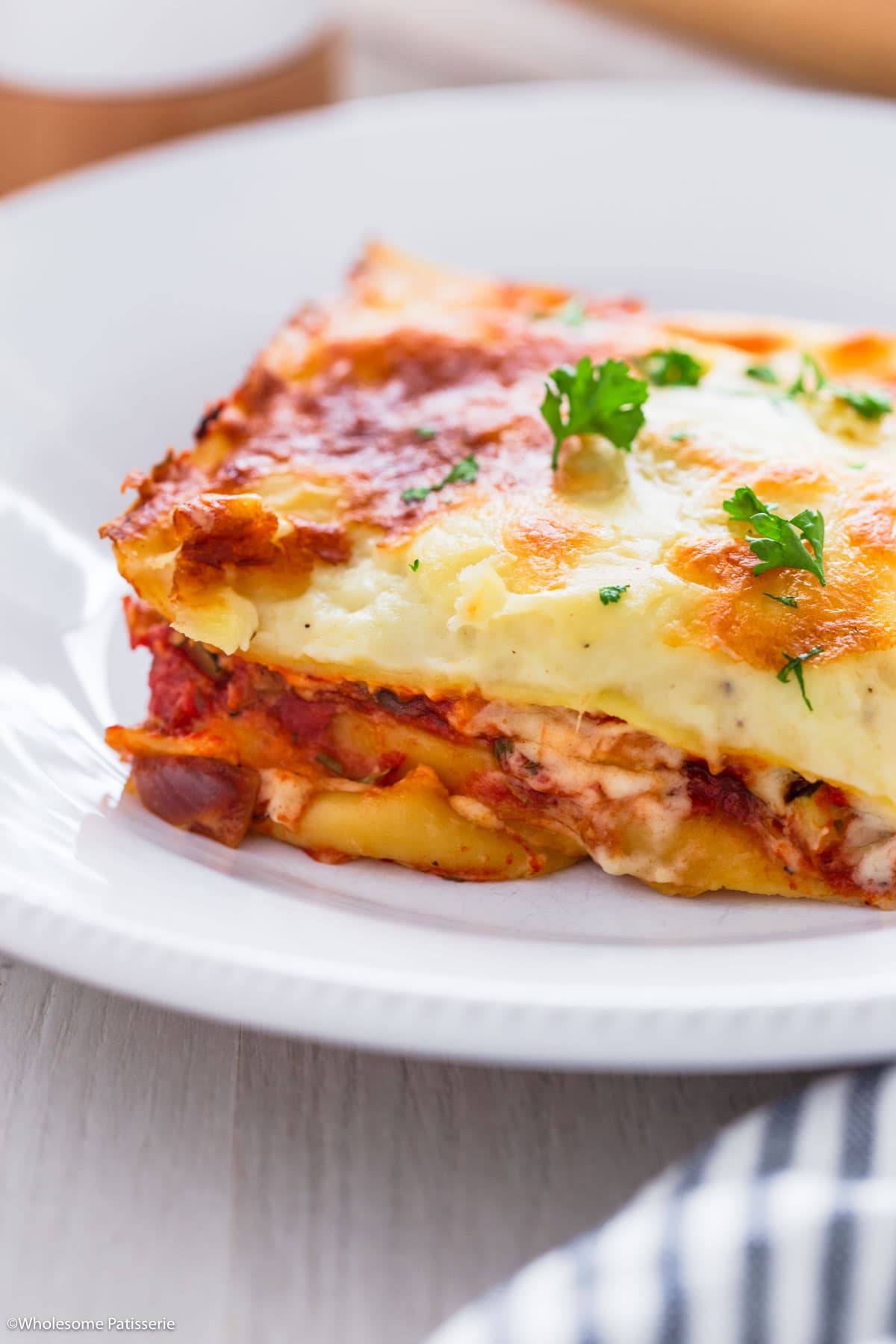
Why Is My Vegetable Lasagna Watery?
Watery lasagna is often due to excess sauce, thin sauce, wet noodles, inadequate baking time, or insufficient resting time post-cooking.
Take the below steps to avoid a watery lasagna.
- Slice your Vegetables Small: In particular the zucchini and eggplant. Chop these into small pieces to avoid excess moisture leaking from them.
- Sauté Vegetables: Cook your veggies well before adding the diced and pureed tomatoes.
- Avoid Adding Extra Tomato Sauce: Stick to the recipe quantities for the canned diced tomatoes and tomato puree. Too much will cause excess water in the lasagna.
- Thick Béchamel: Make sure your white sauce is thick and creamy, not thin and watery.
- Undercooked Noodles: They continue to cook in the sauce while baking, so if they’re too soft to begin with, you will get excess moisture when it’s finished. I recommend using no-boil noodles or fresh noodles.
- Rest Lasagna: Let the lasagna sit for a bit after baking. It helps the layers to settle and absorb any remaining moisture.
Ingredient Notes & Substitutions
A comprehensive recipe card featuring all the ingredients can be found at the end of this post.
Ingredients to Make Vegetable Tomato Mixture
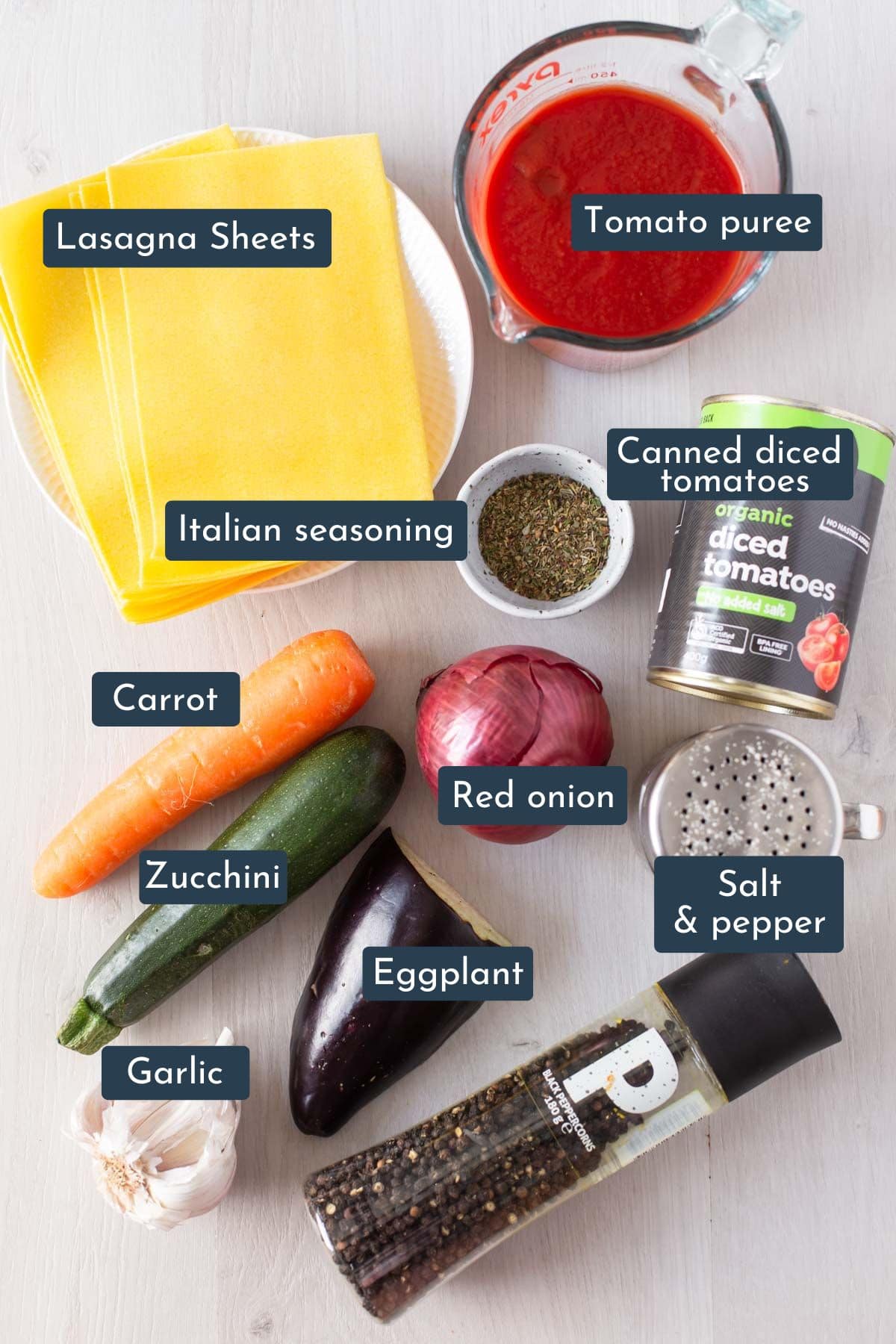
- Butter: Used to sautée your vegetables. Substitute with oil such as olive oil or canola oil.
- Onion: Use either red or brown onion.
- Garlic: Can be substituted with garlic powder. Replace cloves with one teaspoon garlic powder.
- Carrot: Roughly chop into small cubes. Substitute with extra zucchini, bell pepper or parsnip.
- Zucchini: Roughly chop into small cubes. Substitute with extra carrot, eggplant or bell pepper.
- Eggplant: Roughly chop into small cubes. Substitute with extra zucchini, butternut squash or sliced mushrooms.
- Canned Diced Tomatoes: Use the diced tomatoes in juice that comes in a can.
- Tomato Puree: This is also known as Passata. Do not use tomato paste.
- Dried Italian Seasoning: Substitute with a blend of dried basil, parsley, oregano and rosemary. Or use just one of these dried herbs.
- Salt & Pepper: To season.
Ingredients to Make Béchamel Sauce
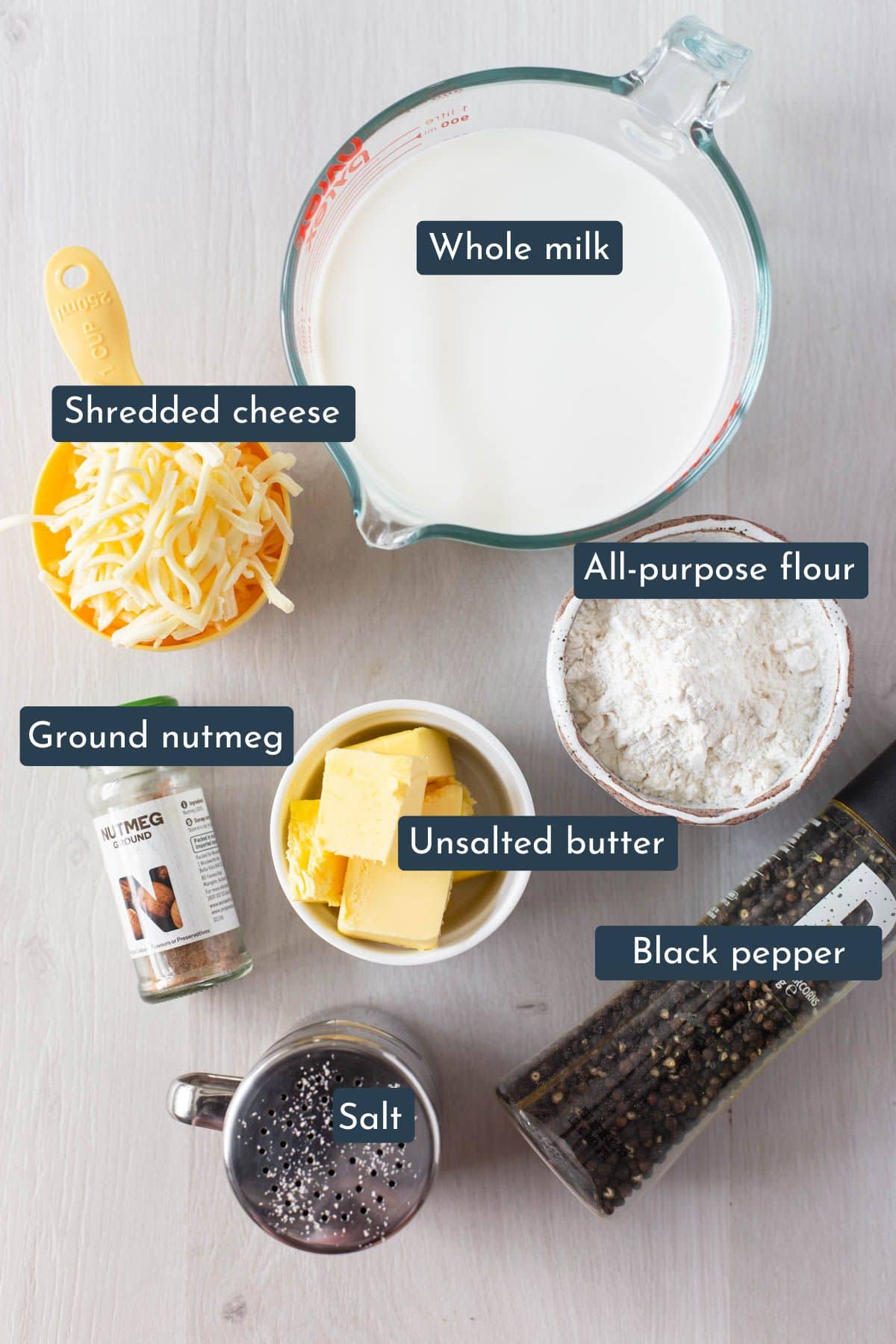
- Unsalted Butter: Use block butter. This recipe has not been tested using coconut oil.
- All-Purpose Flour: Also known as plain flour in Australia. Can be substituted with gluten-free all-purpose flour.
- Whole milk: Full-fat milk offers the best creamy flavor for the white sauce. Can be substituted for skim milk or dairy-free milk.
- Ground Nutmeg: To add flavor to the white sauce. This can be omitted from the recipe without substituting.
- Salt & Pepper: To season.
- Grated Cheese: Frozen or fresh, grated or from a block. I recommend a pizza blend comprising mozzarella, cheddar, and Parmesan. Alternatively, an Italian cheese blend or specific individual cheeses are also suitable options.
- Salt & pepper – to taste.
- Lasagna Noodles/Sheets: Use fresh or no-boil lasagna sheets, also known as oven-ready. Use gluten-free sheets for a gluten-free vegetable tomato lasagna.
- Fresh Parsley: To garnish your lasagna, if desired. May also use freshly chopped basil or rosemary.
🥣 Step By Step Instructions (with photos)
There is a full and detailed recipe card at the bottom of this post.
Step one: Preheat oven to 390ºF (200ºC) fan-forced.
Grease with butter a large 9-inch × 13-inch (22cm x 33cm) rectangular baking dish. Sprinkle some flour over the butter (edges and base) and set it aside.

How to Make Vegetable Tomato Mixture
Step two: Melt butter (or heat oil if using) in a large deep skillet over medium-high heat. Add onion and sauté for 3 minutes until translucent.
Add minced garlic and cook for a further 1 minute, until fragrant.

Step three: Add chopped carrot, zucchini and eggplant and sauté on medium-high for 5 minutes, stirring occasionally.

Step four: Add canned tomatoes, tomato puree and seasonings.
Bring to a boil then reduce heat to low-medium to simmer for 5 minutes, stirring occasionally.
Leave tomato mixture on low heat, not simmering too much, stirring it occasionally, while you make béchamel sauce. This allows the tomato sauce to thicken up.

How to Make Béchamel Sauce
Step five: In a large clean deep skillet or pot add butter and melt over low heat. Then whisk through the flour.

Step six: Increase heat to medium and once gently simmering, cook for 1 minute, while whisking.

Step seven: Pour milk in a slow steady stream while whisking over medium heat.
Continue to cook and whisk over medium heat until it thickens, do not let it boil or simmer, it will thicken before it reaches a bubble.

Step eight: Once thickened, reduce heat to low and whisk through ground nutmeg, and season with salt and pepper to taste.

Step nine: Whisk through 1 cup of the shredded cheese until melted through.
Continue to whisk over low-medium heat until thick and smooth. Turn off the heat and set it aside.


How to Assemble Lasagna
Step ten: Lay one layer of lasagna sheets (4 sheets) in the bottom of the greased baking dish.
Pour half of the vegetable mixture over the sheets, spreading out evenly.

Step eleven: Pour over one-third of the béchamel sauce and spread it over the vegetables.

Step twelve: Place another layer of lasagne sheets (4 sheets) on top of the white sauce.
Step thirteen: Repeat the process one more time. Layer the remaining half of the vegetables, spread over the second third of the white sauce and place another 4 noodle sheets on top.

Step fifteen: Pour and spread over the remaining one-third of the white sauce.

Step sixteen: Sprinkle the remaining 1 cup of shredded cheese over the white sauce.
Bake for 35-40 minutes or until the top is golden and crispy.

Step seventeen: Remove from the oven and allow it to rest uncovered, for 5-10 minutes before cutting and serving.
Garnish with fresh chopped parsley leaves if desired. Serve and enjoy!
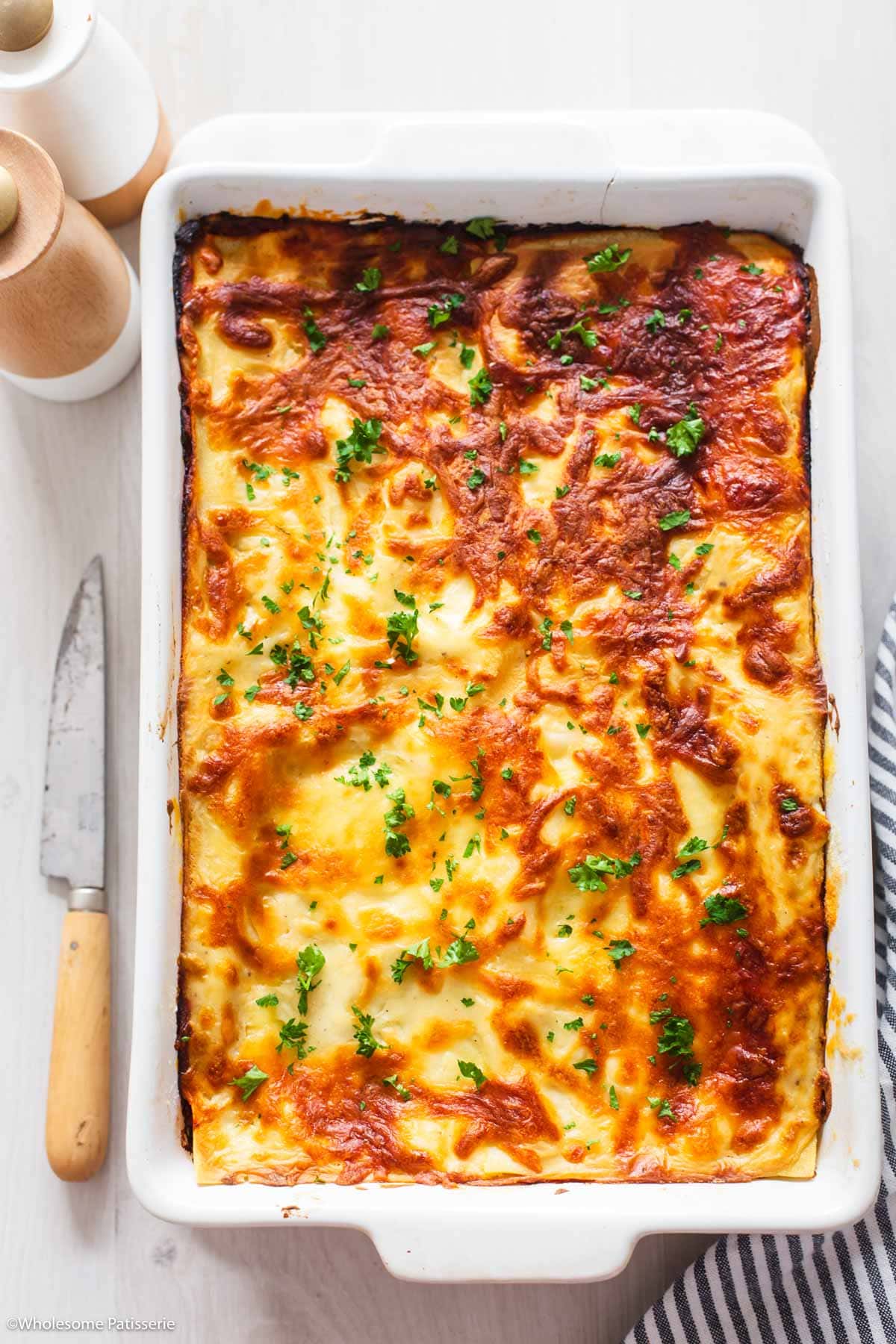
Expert Tips
- Cook Vegetables Well: Until they’re fork-tender. This avoids any excess moisture coming from the zucchini and eggplant that can cause watery lasagna.
- Tomato Sauce Consistency: It’s important to simmer the veggie tomato mixture for 5 minutes. This allows it to thicken up, preventing a watery sauce.
- Thick White Sauce: If it’s too thin and watery, cook it further over medium heat until thick and smooth.
- No-Boil Noodles: If using these, make sure you cover them completely in the tomato sauce layer so they cook properly.
- Rest & Set: Let the lasagna sit for at least 10 minutes after baking. This helps it firm up and makes slicing easier.
Serving Suggestions
Let’s make this vegetarian lasagna a 3-course meal!
- Appetizer: Quick Garlic Herb Flatbread
- Salad: Easy Pasta Salad or Tomato Cucumber Onion Salad
- Vegetable Side: Honey Soy Garlic Veggie Skewers
- Potato Side: Air Fryer Mini Hasselback Potatoes or Roasted Garlic Smashed Potatoes
- Beverage: Rosé Mimosa or Coconut Lemonade
- Dessert: Chocolate Self-Saucing Pudding or Mini Apple Pies

Troubleshooting
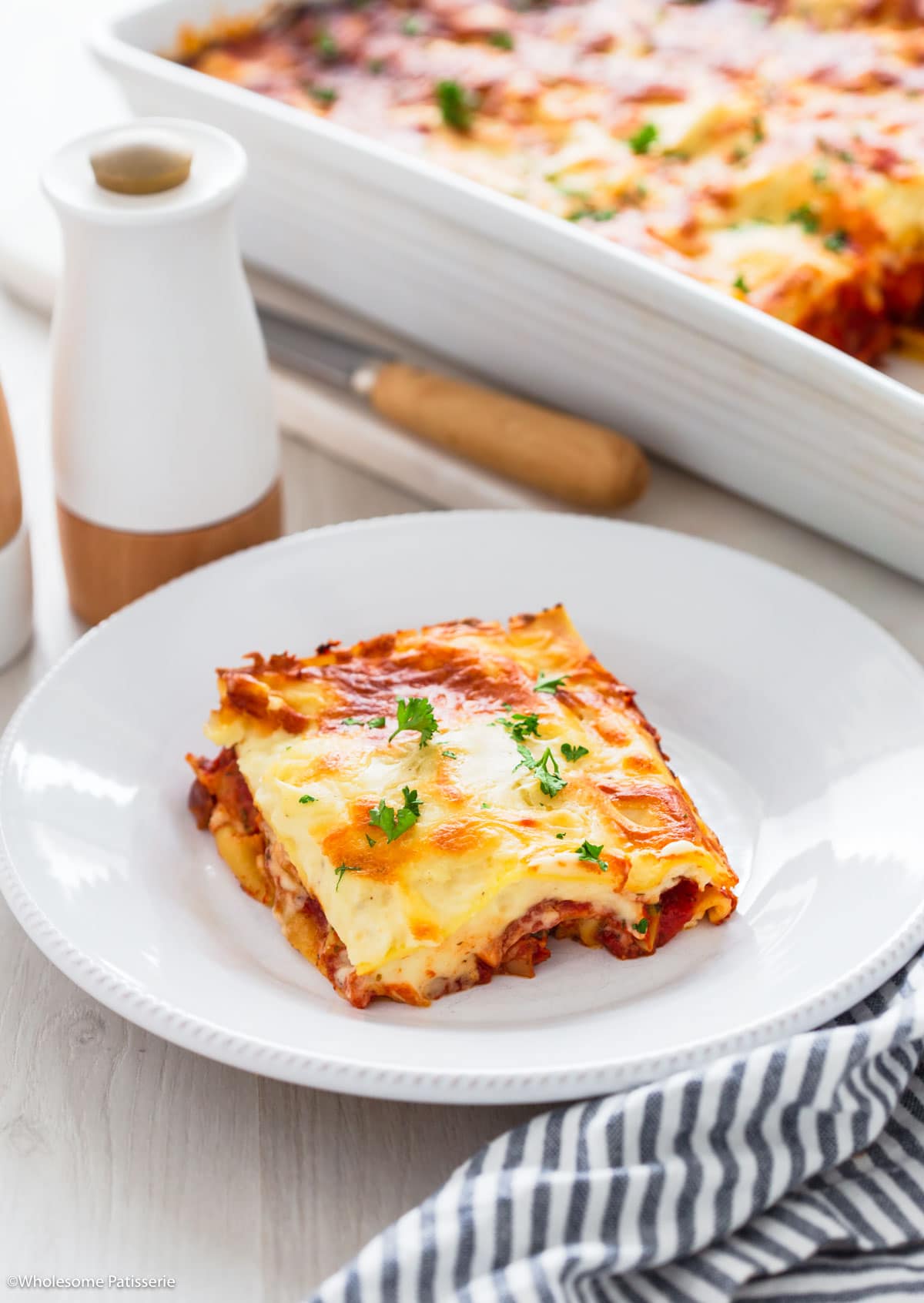
Storage Instructions
Store: Any leftovers still in the baking dish, tightly wrap the dish with cling film, including the sides of the pan, then cover it in foil. Refrigerate for 2-3 days.
Alternatively, store leftovers in individual serving sizes, wrapped in cling film and foil, or in an airtight container, refrigerated, for 2-3 days.
How To Make Vegetable Lasagna Ahead Of Time?
- Assemble & Cool: Make the lasagna and let it cool.
- Wrap: Cover the dish’s sides and top with cling film.
- Foil It: Add a foil layer on top.
- Chill: Refrigerate overnight.
- Prep & Bake: Remove wrapping, let sit for 30 mins at room temperature, then bake per the recipe instructions.
How To Freeze Uncooked Vegetable Lasagna?
- Correct Dish: Use a freezer-safe or disposable baking dish.
- Assemble: Make the lasagna but do not bake it.
- Wrap & Foil: Cover with cling film and foil.
- Label: Date it, so you don’t forget when to use it by.
- Freeze: Into the freezer for 2-3 months.
- Thaw & Cook: Defrost in the fridge overnight, remove wrappings, and bake per the recipe instructions.
How To Freeze Cooked Vegetable Lasagna?
- Cool Completely: Let that lasagna cool.
- Whole or Sliced: Leave it whole in the dish or portion it out into freezer-safe containers or zip-lock bags.
- Wrap & Foil: If leaving it in the dish, wrap the dish’s sides and top with cling film and foil.
- Label: Date it, so you don’t forget when to use it by.
- Freeze: Into the freezer for 2-3 months.
- Thaw & Reheat: Defrost in the fridge overnight, remove wrappings, and reheat in a preheated oven at 350ºF (175ºC), covered with foil to avoid it browning too much on top.

Recipe FAQ’s
If you enjoy this recipe, please consider leaving a ⭐️ star rating and a comment review below. I love to hear what you think and it’s much appreciated. Thank you! Your email address will not be published. Sam x

Easy Vegetable Lasagna with Tomato
Ingredients
Vegetable Tomato Mixture
- 1 Tbsp unsalted block butter, or olive oil
- 1 large red onion, peeled and roughly diced
- 3 cloves garlic, peeled and minced
- 1 large carrot, chopped into small cubes
- 1 large zucchini, chopped into small cubes
- 1/2 eggplant, chopped into small cubes
- 14.5 oz (400g) canned diced tomato, in juice
- 1 1/2 cups (14.5oz/400g) tomato puree/passata, not tomato paste
- 1 Tbsp dried Italian seasoning
- Salt and pepper, to season
Béchamel Sauce
- 90 g unsalted block butter
- 6 tbsp all-purpose flour
- 3 cups whole milk
- 1/4 tsp ground nutmeg
- Salt and pepper, to season
- 2 cups frozen or fresh shredded cheese, cheddar, Italian or pizza blend
- 12 sheets (340g/12oz) fresh or no-boil/oven-ready lasagna noodles, can use gluten-free noodles
- 1 tbsp fresh chopped parsley, to garnish
Instructions
Vegetable Tomato Mixture
- Preheat oven to 390ºF (200ºC) fan-forced.
- Grease with butter a large 9-inch × 13-inch (22cm x 33cm) rectangular baking dish. Sprinkle some flour over the butter (edges and base) and set it aside.
- Melt butter (or heat oil if using) in a large deep skillet over medium-high heat.
- Add onion and sauté for 3 minutes until translucent.
- Add minced garlic and cook for a further 1 minute, until fragrant.
- Add chopped carrot, zucchini and eggplant and sauté on medium-high for 5 minutes, stirring occasionally.
- Add canned tomatoes, tomato puree and seasonings. Bring to a boil then reduce heat to low-medium to simmer for 5 minutes, stirring occasionally.
- Leave tomato mixture on low heat, not simmering too much, stirring it occasionally, while you make béchamel sauce. This allows the tomato sauce to thicken up.
Béchamel Sauce
- If using frozen cheese, leave it out now to defrost.
- In a large clean deep skillet or pot add butter and melt over low heat.
- Once melted, whisk through the flour.
- Increase heat to medium and once gently simmering, cook for 1 minute, while whisking.
- Pour milk in a slow steady stream while whisking over medium heat.
- Continue to cook and whisk over medium heat until it thickens, do not let it boil or simmer, it will thicken before it reaches a bubble.
- Once thickened, reduce heat to low.
- Whisk through ground nutmeg, and season with salt and pepper to taste.
- Whisk through 1 cup of shredded cheese until melted through.
- Continue to whisk over low-medium heat until thick and smooth. Turn off heat and set aside. Turn off tomato veggie mixture too.
Assemble Lasagna
- Lay one layer of lasagna sheets (4 sheets) in the bottom of the greased baking dish.
- Pour half of the vegetable mixture over sheets, spreading out evenly.
- Pour over one-third of béchamel sauce and spread it evenly over vegetables.
- Place another layer of lasagna sheets (4 sheets) on top of the béchamel sauce.
- Repeat the process one more time. Layer the remaining half of vegetables, spread over second third of the béchamel sauce and finally, place another 4 noodle sheets on top.
- Pour and spread over remaining one-third of béchamel sauce.
- Sprinkle remaining 1 cup of shredded cheese over béchamel.
- Bake for 35-40 minutes or until top is golden and crispy and filling is bubbling up slightly from the sides.
- Remove from oven and allow to rest uncovered, for 5-10 minutes before cutting and serving.
- Garnish with fresh chopped parsley leaves if desired.
- Serve and enjoy!
Notes
- Vegetables: Don’t have these particular veggies on hand? Use any vegetables you want instead. Just chop them small. Good ones to use are squash, broccoli, cauliflower, peas and sliced mushrooms.
- Tomato Sauce Consistency: It’s important to simmer the veggie tomato mixture for 5 minutes. This allows it to thicken up, preventing a watery sauce.
- Lasagna Noodles/Sheets: Use fresh or no-boil lasagna sheets, also known as oven-ready. Use gluten-free sheets for a gluten-free vegetable tomato lasagna.
- Rest & Set: Let the lasagna sit for at least 10 minutes after baking. This helps it firm up and makes slicing easier.
- Store: Leftovers in the original baking pan, tightly wrapped in cling film and covered with foil, for 2-3 days in the fridge. Alternatively, portion leftovers into individual servings and store in airtight containers, also for 2-3 days in the fridge.
- To freeze uncooked lasagna: First assemble it in a freezer-friendly or disposable dish. Do not bake. Tightly wrap the dish in cling film and add a foil layer on top. Mark it with make and freeze dates, plus a use-by date. Store in the freezer for up to 2-3 months.
- To thaw and cook: Move the uncooked frozen lasagna to the fridge and let it defrost overnight. Remove all wrappings and bake as per the original recipe instructions.
- To freeze cooked lasagna: Cool it fully, leave whole or in individual servings, wrap in cling film, then foil or place in a freezer-safe container. Label with the make, freeze, and use-by dates. Freeze up to 2-3 months.
- For thawing and reheating frozen cooked lasagna: Move frozen lasagna to the fridge overnight. Once thawed, remove wrappings and reheat in a preheated oven until fully warmed.
